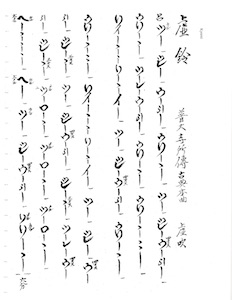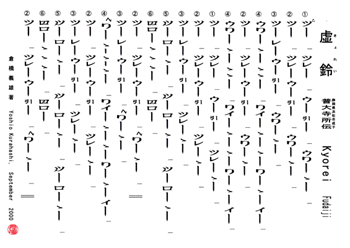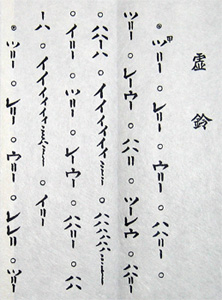Honkyoku Music

Honkyoku, meaning "original pieces", are compositions for the shakuhachi that were written by komusō monks to be played for suizen, "blowing meditation", begging for alms, and to express nature. The komusō monks formed the Fuke Sect of Zen Buddhism, making suizen their primary form of meditative practice. Most honkyoku that are known today were composed by komusō monks in the Edo Period (1603 - 1868).
During the Meiji Restoration, beginning in 1868, the Japanese government destroyed all of the known Fuke Sect temples in an attempt to rid Japan of Buddhism, and banned komusō monks from practicing. Later in the Meiji Period the Japanese government agreed to allow the use of the shakuhachi as a secular instrument, and eventually, as Buddhism was again allowed to be practiced, the playing of honkyoku reemerged. Fortunately, many honkyoku survived and have been passed down through various temple lineages and collections.
Today there are a number of different shakuhachi schools or styles, each with their own collection of honkyoku. Some honkyoku are played in more than one school, and in these cases there are often some modifications to the compositions and the way they are played. Rather than duplicate what is already online, you can find a list of the different styles and the honkyoku they use here.
Honkyoku have a unique structure that is perfectly suited to suizen. They have no rhythm and no real melody, and are made up of individual phrases, each the length of one exhalation. The phrases are connected by moments of silence, and the silence is considered to be the same as the sound.
Written Notation

Honkyoku are written using the Japanese katakana alphabet. Each "note" represents a certain fingering on the shakuhachi. For example, the character ro (ロ) corresponds to having all finger holes covered, and the character tsu (ツ) corresponds to having all but the last finger hole covered. Sharps and flats are indicated with a small character next to the main note, for example me (メ) is used to flatten a note. The relative length of a note in a given phrase is indicated by a line drawn downward or outward from the note. If there is no line the note is meant to be sounded shortly. If there is a line, the note should be extended. Because each phrase is meant to last one full exhalation, the notes written for one phrase are divided proportionally based on the length of the exhalation. Each phrase/breath is separated by either a horizontal line or a circle.
While written honkyoku music may look intimidating at first glance to someone unfamiliar with katakana, in my opinion it is significantly easier to read than Western notation. Honkyoku notation is very visual, and learning to read it from scratch can be done in a matter of hours.
Fingering Charts
Below are fingering charts from different schools that show the katakana symbols and corresponding shakuhachi fingering:
Honkyoku Compositions

In my experience, it is not easy to find free copies of honkyoku compositions. The various schools in Japan tend not to make the compositions freely available, and even when studying with a teacher they are given out one at a time, as each composition is taught. Where they can be found available for sale, the cost is generally very high compared to western sheet music. In my view this is a shame. Honkyoku are cultural, spiritual, and musical treasures that would be best shared freely, particularly due to the fact that the original composers are no longer living.
On the other hand, there are subtleties to honkyoku that tend not to come across in the notation. Most notation I have seen for example is missing markings that would indicate certain notes or changes in tone. Additionally, teachers from the various schools do not want people getting their hands on the notation, playing it incorrectly, and misrepresenting the honkyoku.
On balance, I still feel that honkyoku from the various schools should be made available to all. This additional exposure would do more good than harm in my opinion. So when I've been able to find sheet music freely shared by teachers, or when I've been able to get permission to post it, I will include links to the music below. Please keep in mind that study with a qualified teacher is always recommended. Where it is not possible, listening to recordings of the compositions along with the sheets, and attempting to play along with the recordings, is a good substitute.
Honkyoku Links and Downloads
- Here are 13 honkyoku written and published by the well known and highly regarded shakuhachi master, Yodo Kurahashi. They include the Jin Nyodo versions of Kyorei, Choshi, and Banshiki, three of my favorite pieces for suizen.